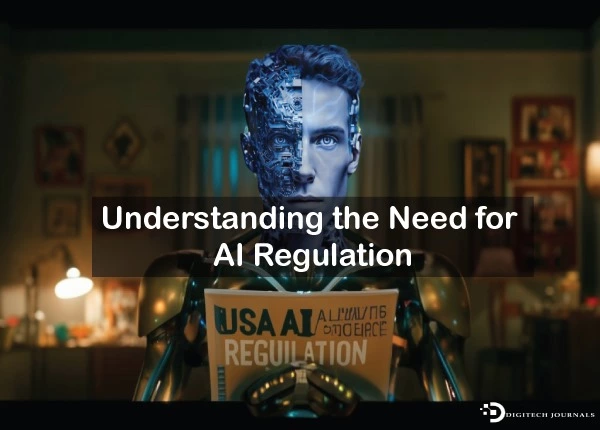Taking a momentous stride, President Joe Biden recently signed the inaugural executive order on ensuring the safety, security, and reliability of artificial intelligence engineering (AI) in the United States. This groundbreaking action underscores the administration’s dedication to striking a balance between fostering innovation and upholding accountability in the dynamic realm of AI.
Understanding the Need for AI Regulation
The executive order signals a watershed moment in the regulation of AI technologies, laying the foundation for a future where the promise of AI can be harnessed responsibly. With a focus on transparency and responsible machine development, the order aims to ensure that AI benefits society while minimizing potential risks. This balanced approach is in sync with President Biden’s broader strategy for responsible innovation.

What AI Developers Need to Know: The order introduces a set of responsibilities for developers of powerful AI systems, underscoring the importance of sharing safety test results and crucial information with the U.S. government. This push for transparency is a giant step towards ensuring accountability in the development and deployment of advanced AI technologies.
Alongside transparency, the order calls for the development of robust safety and security standards for AI. This includes creating standards, tools, and tests to ensure that AI systems are not only cutting-edge but also safe, secure, and trustworthy. Notably, the order aims to protect Americans from AI-enabled fraud and deception by setting standards and best practices for detecting AI-generated content, setting a benchmark for global standards.
Furthermore, the order addresses potential risks linked to the use of AI in biological synthesis, introducing new standards to shield against the creation of dangerous biological materials. Compliance with these standards becomes a prerequisite for federal funding for life-science projects, highlighting the administration’s commitment to the responsible use of AI in critical areas.
National Security and Keeping Risks in Check
The executive order goes beyond immediate responsibilities for developers, envisioning a comprehensive strategy for national security in the era of AI. Drafting a National Security Memorandum is set to steer subsequent actions, guaranteeing the ethical, safe, and efficient deployment of AI by the U.S. military and intelligence community. This proactive strategy cements the U.S.’s position as a frontrunner in establishing the ethical parameters of military AI applications on a global scale. Simultaneously, the establishment of Sector Risk Management Agencies (SRMAs) plays a pivotal role in analyzing and minimizing risks associated with the deployment of AI-based solutions across 16 critical infrastructure sectors. This two-pronged strategy underscores the administration’s commitment to safeguarding national security while fostering technological advancements.
Comparing Notes: How the U.S. and EU Approach AI Risks
Drawing parallels with the European Union’s approach to AI risks, the U.S. executive order aligns with the emphasis on risk analysis and management. The EU’s draft AI Act categorizes AI use into different risk levels—unacceptable, high, limited, and minimal—providing a framework for regulatory measures. While both approaches share common ground, the U.S. executive order stands out for its emphasis on the social responsibility of AI.
The order explicitly addresses the potential for discrimination, bias, and other abuses in justice, healthcare, and housing arising from irresponsible AI uses. It goes beyond mere regulation, providing guidelines for AI systems in various societal sectors to ensure that AI serves as a technological solution that reduces societal inequity rather than contributing to discrimination.
“Irresponsible uses of AI can lead to and deepen discrimination, bias, and other abuses in justice, healthcare, and housing.”
Social Responsibility: AI’s Role in Shaping Society
A standout feature of the U.S. administration’s approach is its emphasis on the social responsibility of AI. Acknowledging that irresponsible AI applications can exacerbate discrimination and bias, the order outlines guidelines for AI systems in critical areas such as housing, social welfare, justice, education, and the labor market.
In the realm of labor, the order not only acknowledges the promise of improved productivity from AI-based tools but also anticipates potential challenges such as increased surveillance, job displacement, and the collection and processing of workers’ data. To address these challenges proactively, federal agencies are provided with guidance to prevent underpayment of workers, unfair evaluations of job applications, and interference with workers’ ability to organize.
Moreover, the order initiates a comprehensive study on AI’s potential impacts on the labor market, demonstrating the administration’s commitment to understanding and addressing the evolving dynamics between AI and employment.
State and Federal Initiatives: Nurturing AI Development Ground-Up
The executive order sets in motion a series of state and federal initiatives designed to foster a conducive environment for AI development. From developing guidance for agencies’ use of AI to expediting the acquisition of AI products and services, these initiatives aim to streamline processes and provide support for agencies at all levels.
One significant aspect is the focus on AI training for employees across various sectors. Recognizing the transformative potential of AI, the order aims to equip the workforce with the necessary skills to navigate the AI landscape effectively. Additionally, the order emphasizes the importance of ensuring that small entrepreneurs and developers have access to technical assistance and resources, promoting fair competition and a level playing field in the AI ecosystem.
U.S. Dual Leadership: Technology and Regulation Hand-in-Hand
The U.S. is not only positioning itself as a leader in technological solutions but is also taking a proactive stance in AI regulation. The order seeks to catalyze AI research through the pilot of the National AI Research Resource, providing essential resources and data to researchers and students. This initiative aims to keep the U.S. at the forefront of AI innovation by supporting advancements in crucial areas such as healthcare and climate change.
“America wants to lead the way in technology solutions and attract the best.”
Furthermore, the order underscores the importance of fair competition in the expanding AI ecosystem. By ensuring that small entrepreneurs and developers have access to technical assistance and resources, the administration aims to create a level playing field for the commercialization of breakthrough AI solutions.
In a bid to strengthen the U.S. workforce, the order outlines plans to modernize the visa process, attracting highly skilled AI workers and students to contribute to the nation’s leadership in AI technology. This dual approach to technology and regulation reflects a nuanced understanding of the interconnected nature of innovation and governance.
Privacy Protection and International Cooperation
Amid the rapid advancements in AI capabilities, the executive order draws attention to the critical need to protect personal data. The order emphasizes the combination of AI capabilities with advanced data protection technologies, such as cryptographic tools. The order also underscores the importance of allocating funds for research aimed at expediting the advancement of techniques that preserve privacy.
President Biden has urged Congress to expedite efforts to craft privacy legislation, emphasizing a targeted focus on safeguarding the well-being of all Americans, particularly children. The order emphasizes the importance of developing guidelines for federal agencies to evaluate the effectiveness of privacy-preserving techniques, data collection methods, and the purposes for which personal information is used.
International cooperation is deemed essential in this regard, recognizing that addressing global challenges, such as advancing sustainable development and mitigating threats to critical infrastructure, requires collaborative efforts. The order underscores the importance of using AI as a tool to tackle these challenges while emphasizing the need for ethical considerations in international AI cooperation.
The Biden AI Revolution: Voices and Perspectives
News of the executive order has reverberated across the media landscape, sparking a nuanced dialogue on what some are calling the “Biden AI revolution.” Experts in the field of AI have lauded the administration’s commitment to regulations, citing the necessity of measures to protect citizens from potentially harmful actions stemming from AI applications.
“Leaving AI issues out of public control would pose a serious civilizational risk to humanity, and possibly even an existential one.”
Conversely, some voices in the industry express reservations about the perceived rigidity of the adopted approach, viewing it as a potential impediment to technological innovation. These concerns were echoed at a recent global summit hosted by UK Prime Minister Rishi Sunak, where key figures from the realms of power and technology debated the need for controlled development of artificial intelligence.
As we closely monitor all regulatory developments in the AI market, it becomes evident that the Biden administration’s approach seeks to strike a delicate balance between innovation and responsibility. The ongoing discourse surrounding the potential risks and rewards of AI regulation will undoubtedly shape the future trajectory of the technology landscape.
Ultimately, President Biden’s historic executive order on AI regulation signifies a monumental step toward responsible AI development. By addressing critical concerns related to safety, security, societal impact, and privacy. The United States is positioned to take the lead in shaping the future landscape of AI technology. As we navigate this transformative era in AI, continuous monitoring of regulatory developments remains essential to keep our readers informed about the evolving landscape of artificial intelligence.



